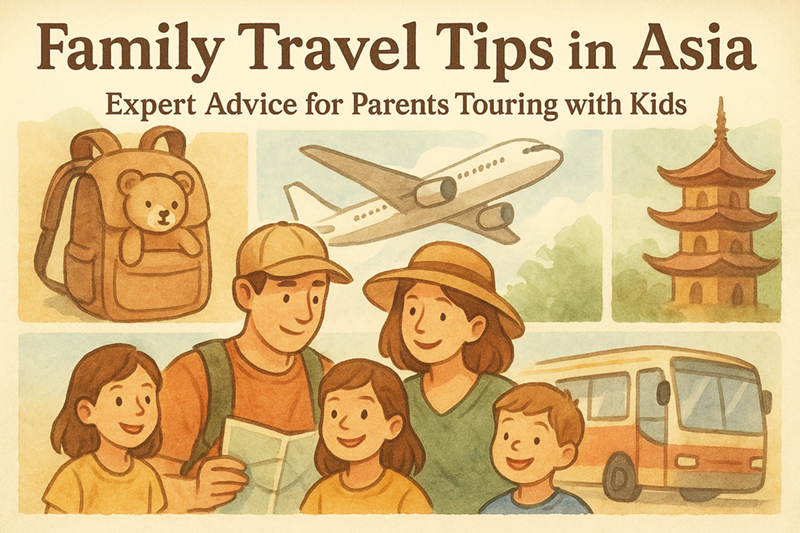Best Tips for Traveling with Kids on Southeast Asia’s Public Transport: Subways, Tuk-Tuks & More
Traveling through Southeast Asia with young kids is an adventure, but it’s also a juggling act. Over the years, I’ve learned a lot about navigating busy streets, crowded trains, and chaotic tuk-tuks with my two kids (ages 4 and 8). Here’s what really worked—no fluff, just honest advice based on real experience.
Mastering the Subway Systems in Bangkok and Ho Chi Minh City
Bangkok’s BTS Skytrain and MRT subway are a lifesaver. They’re fast, clean, and cheap. When we stayed at the Siam Kempinski Hotel, right near Siam Station, taking the BTS was seamless. The train staff is friendly, and stations usually have elevators—huge plus with kids and strollers.
Pro tip: Use the Line App or Google Maps to plan your route. Trains get crowded during rush hour, so try to avoid peak times (7:30–9:00 am, 5:00–7:00 pm). We once tried to squeeze into a packed train in Ho Chi Minh City during rush hour, and it was chaos. Instead, we waited 20 minutes and took a less crowded train—much calmer.
For younger kids, carry a lightweight, foldable stroller. Kids can hop on and off easily, and it saves their legs. Also, always keep a bottle of water and snacks handy. Trains can be hot and crowded, so staying hydrated helps.
Navigating Tuk-Tuks in Bangkok and Da Nang
Tuk-tuks are iconic, but they can be tricky with kids. In Bangkok, we used them mainly for short trips like from the hotel to Chatuchak Market or around old town. They’re fun, quick, but also noisy and sometimes unpredictable.
Pro tip: Agree on the fare before you get in. Many drivers will try to overcharge tourists. Show the driver the approximate fare on a map or a local app like Grab. Also, insist on sitting in the back seat—it’s safer and easier to keep an eye on kids.
In Da Nang, tuk-tuks are great for short rides, especially around My Khe Beach or to the Dragon Bridge. Keep in mind that some rides can be bumpy, so a small cushion in the tuk-tuk can make the ride more comfortable for little backs.
What surprised us: Kids are captivated by tuk-tuks and love hanging out the window. But the noise and exhaust fumes can get overwhelming if you’re not careful. After a few rides, we switched to grab cars for longer distances.
Using Grab and Local Ride-Hailing Apps for Convenience and Safety
In both Bangkok and Vietnam, Grab (the Southeast Asian Uber) became our go-to. It’s safer, more comfortable, and you can pick a private car or a motorbike if your kids are older. We used Grab in Hanoi to get from the airport to the Hanoi La Siesta Hotel & Spa and it was smooth.
Pro tip: Always select the car option with the child seat if you have young kids. Not all drivers have one, but some do. It saves the hassle of bringing your own portable seat.
For longer trips, like from Ho Chi Minh City to Cu Chi Tunnels or from Da Nang to Hoi An, Grab was reliable and convenient. It also avoids the chaos of street hailing in heavy traffic.
Tips for Traveling with Kids on Buses in Southeast Asia
Buses are often overlooked but can be a good option for longer trips. We took a sleeper bus from Bangkok to Chiang Mai and a sleeper bus from Hanoi to Sapa. Both were surprisingly comfortable.
Pro tip: Bring a small pillow and a blanket. The bus staff usually have them, but they run out quickly. Pack snacks and water; bus stops can be infrequent. Also, hold onto little hands tightly, especially on night buses when kids tend to drift off or get restless.
Be prepared for occasional delays and bumpy roads. Our kids loved the novelty of sleeping on a bus, but a tablet loaded with movies or coloring books helped keep them entertained.
Tips for Traveling with Young Kids on Trains in Southeast Asia
Train travel is one of the best ways to see the countryside. The train from Bangkok to Chiang Mai is scenic and comfortable. We booked seats in advance at Bangkok Railway Station and chose a soft sleeper. It’s worth it for comfort and space.
In Vietnam, the Reunification Express from Hanoi to Da Nang or Ho Chi Minh City to Nha Trang is iconic, but it can be crowded. We traveled in soft seats and brought a foldable table for snacks. Kids loved looking out the window and watching the scenery pass.
Pro tip: Book tickets early online or at the station, especially during peak season. Bring plenty of snacks, water, and wipes. Trains are not always super clean, so be prepared.
Tips for Beach Travel with Kids: Best Kid-Friendly Beaches in Da Nang and Phuket
Beach days are a must in Southeast Asia. For families, I recommend My Khe Beach in Da Nang. It’s wide, sandy, and has shallow waters. We stayed at the Vanda Hotel, which is right on the beach, making it easy to come and go.
Pro tip: Bring a sunshade tent or beach umbrella. The sun can be fierce, especially midday. Pack plenty of water, hats, and reef-safe sunscreen. Keep a close eye on kids in the water—waves can surprise you.
In Phuket, Patong Beach is lively but busy, so we preferred quieter beaches like Freedom Beach or Kata Noi Beach. They’re calmer and less crowded, ideal for little ones to splash around safely.
Using Public Transport to Reach Attractions and Beaches
In cities, public transport gets you closer to attractions without the hassle of parking or traffic. In Bangkok, we used BTS to visit Grand Palace and Wat Arun. In Ho Chi Minh City, buses took us to Saigon Notre-Dame Basilica and Ben Thanh Market.
Pro tip: Download offline maps and local transport apps. They help figure out routes and schedules quickly. Kids can get bored waiting, so carry small toys or books for downtime.
At beaches, taxis or grab are best for reaching remote spots like Freedom Beach or Ao Nang. For quick trips, local songthaews or motorbike taxis are an option but not ideal with small kids unless you’re comfortable with the safety precautions.
Final Thoughts
Traveling around Southeast Asia with kids requires flexibility and planning, but it’s totally doable. The key is knowing your options and having a few tricks up your sleeve. Strollers, snacks, apps, and clear fare agreements make a huge difference.
Be patient with the chaos. Kids thrive on routine, but in Asia’s vibrant streets and busy transport hubs, adaptability is your best friend. And honestly, the surprises—good and bad—make the trip memorable. With these tips, you’ll find it easier to enjoy Southeast Asia’s incredible sights without stressing about every little detail.

